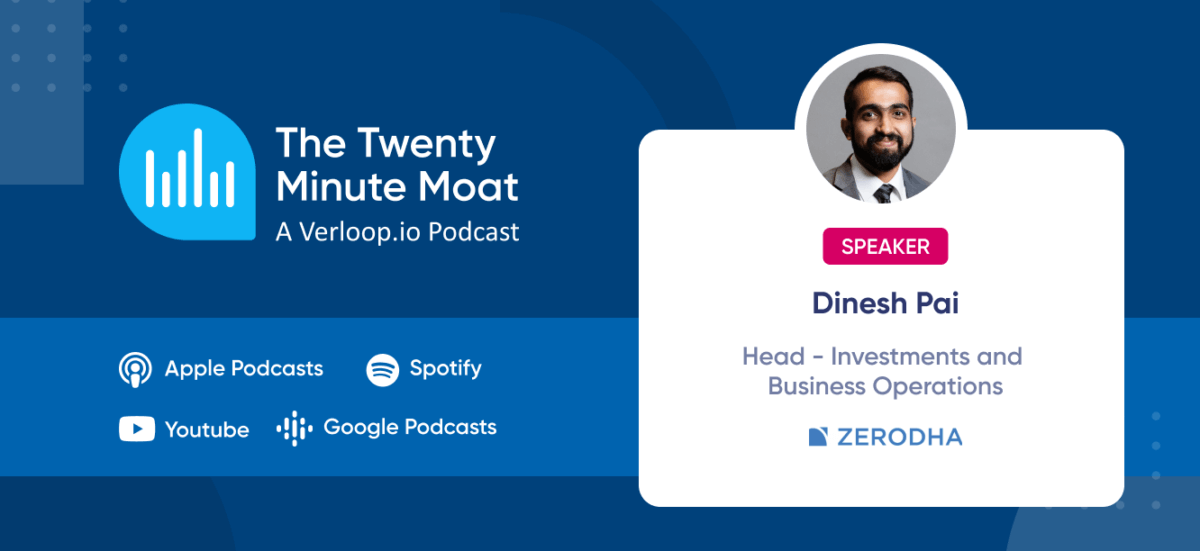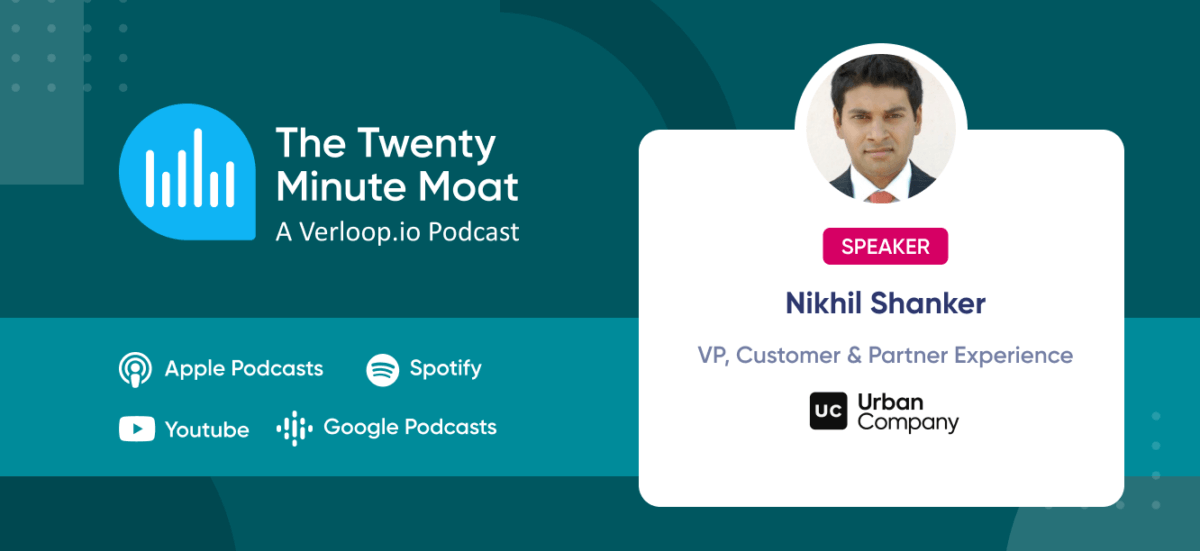Duration 22:10
Guest Speaker

Sameer Nagpal
Director - Customer Happiness, WazirX
Sameer Nagpal is a strategy and operations leader in the servicing industry with over 13 years of experience in building high performing servicing teams with different organizations. He leads Customer Service at WazirX, India’s largest cryptocurrency exchange focused on simplifying the crypto experience for the people of India.
We cover:
- [03:06] What does customer support at WazirX look like?
- [05:24] How do measure customer support effectiveness?
- [08:07] How has customer support evolved in the past few years?
- [11:19] What channels do your users prefer?
- [16:32] What impact has AI and automation had on the support space?
Podcast Transcript
In this future of customer support podcast, we have Sameer Nagpal as our podcast guest and Siddharth Sharma as our podcast host.
Siddharth Sharma
Today I have Sameer with me. Sameer is a Fintech expert when it comes to customer support, right. Welcome to the show Sameer.
Sameer Nagpal
Thanks, thanks Siddharth. Great to be here.
Siddharth Sharma
Welcome to the show Sameer. Could you tell us a bit more about yourself?
Sameer Nagpal
Yeah, so I’ve been with the banking and financial services industry pretty much in servicing my entire career. Currently, I lead servicing for WazirX, India’s largest cryptocurrency exchange.
And prior to that, I was with another banking… banking Industry company for almost 13 years. So it’s been… it’s been pretty much in the servicing… uh… servicing industry positions.
Siddharth Sharma
I think you worked for…I mean, in the banking space so much.
Right? And, now with uh… I mean, everyone who’s listening to this would really love to know about cryptocurrency, right?
It’s all the rage after bitcoins… it’s suddenly boomed up, and you know, created
I mean, it’s… to be very honest, it’s created enormous wealth for a lot of folks as well, folks who had believed in cryptocurrency as an asset, right? So, I mean, what’s been your personal insight, right? How has this space grown over the last couple of years? And you have seen it from close quarters. So it’ll be great to hear your thoughts.
Sameer Nagpal
Uh, I think….So, I would still consider myself a crypto beginner… beginner, maybe an intermediate. Definitely not an expert.
But my personal thing has been… definitely in the last six months, the… the crypto industry has gone mainstream, right?
Before that, at least for the Indian market, it was almost a… an industry that was in the shadows.
Now if you… if you watch the Telly, if you watch cricket, you will have lots of exchanges promoting uh..crypto. So it’s really gone mainstream in the past few months. And that’s really caught on with a lot of institutional investors coming in and a lot of people taking it really seriously.
Thinking of it as an asset class first and foremost, and maybe a currency to… to… to uh…maybe uh…go against gold at some point and maybe… maybe the US dollar as well.
Siddharth Sharma
For a very long time, uh… you know, and… and I… and I could account this from my childhood, right? We went to an exhibition in Bangalore and that time somebody tried to sell a Bitcoin to my dad, right? And my dad was like, what is this?
Why are you giving me a fancy gold looking coin and all. And he’s like, oh this is just like a showpiece. You actually don’t own it. You actually need a USB stick. I’ll give you a key and everything. And my dad was like, no, no, no, I don’t need all this, right? And I still remember that moment very firmly even now, because if he had bought a Bitcoin then, uh… today… today I would be sitting on like… Gazillion of dollars.
Sameer Nagpal
I know. Everyone seems to have these stories, right? Uh… like if you would have invested so and so at in 2010, it would be so much. If you had invested in point…
[03:06] Siddharth Sharma
The information at that time was very limited, right? I mean, nobody knew what a Bitcoin was. I mean I… I was lucky I was in that exhibition with my dad.
But before that and even after that, I was like, OK, it’s like some fad or something, or maybe it’s just, I mean, For… for a long time, I thought it was a scam, to be very honest, crypto was a scam. But now, as you said, it’s gone very mainstream. For me, it’s an asset class as well. For retail investors, for a very layman retail investor. So, I think, WazirX has done a lot of work into making it into one of the asset classes that people can invest in. So…. I think you folks have done brilliantly.
And with cryptocurrency, right, you know, like a layman, I have so many questions. Your customers also would have a lot of questions, right?
So what does the customer support organisation, you know, look like in… in WazirX?
Sameer Nagpal
So, servicing in WazirX or customers… customer support organization has about close to 250 K engagements that we receive over a month. Across four different channels, which is email, voice, chat and social… social media, OK. Emails is our most well established channel. It’s been there since the time that WazirX came to prominence.
Voice chat and socials, have been the channels that we have started recently.
In the current scheme of things, we definitely see them playing a much stronger role, uh… as we move forward as well.
Siddharth Sharma
Sure, when you talk about the team structure, because, you know, in a customer support organization, it’s a team that makes or breaks it. So how does that play out?
Sameer Nagpal
So like I said, our emails team is the most well established and the most prominent team that we have at the moment.
Voice would come in as a close second.
Chats and socials are really just coming up but we feel the way that the market is going, the way the customer is going with a lot of millennials coming in, we definitely feel that those are the two teams that will continue to grow.
Uh..and we might just see emails and voice reduce overtime and then chat and… chat and definitely social messenger and all of that uh..increase over time.
[05:24] Siddharth Sharma
Got it. And, you know, since you’ve been in the field and on the frontline for so long, right?
And this is the question which I had really wanted to ask. How do you measure effectiveness when it comes to support?
Sameer Nagpal
So I think if you… if we… if we think about effectiveness, effectiveness is when a customer comes to you, you understand what he’s asking you to do, and you deliver on that, right? That’s pretty much effectiveness.
The most important metric for that, in my opinion, is your regular CSAT or customer satisfaction or whatever we want to call it.
We measure a hosts of internal metrics for response times, for resolutions, for quality, for different parameters, but again, your CSAT is the king metric when you talk about your services organisation.
Siddharth Sharma
Alright. Yeah.
And when you talk about CSAT, right, I mean, as your north star metric, what are the other metrics you folks look at on a daily basis?
Because I’m sure with WazirX, right, you have a gazillion metrics and gazillion dashboard that you look at, right?
Uh…so if you could give us some insight on those as well.
Sameer Nagpal talks about customer service metrics
So absolutely. I mean, internally there are multiple that we look at, like what is the…First response is one, full resolution is one.
We have different parameters for quality in terms of how well we are capturing all the things that we want to communicate to a customer, in terms of empathy, in terms of humanising, in terms of understanding well.
So there are like you said, there are Gazillions of metrics.
I mean, I can keep going on. There are over I think, 30 or 35 different parameters that we look at for every different ticket. And similarly for metrics as well.
Siddharth Sharma
And these metrics are looked at on a daily, weekly, monthly and a quarterly basis?
Sameer Nagpal
Pretty much.
Siddharth Sharma
Wow. And all this comes onto your shoulders.
Sameer Nagpal
So we do have a lot of metrics.
But at the same time, what we do have is an extremely high performing team that is very, very, very, very good at their work.
I wouldn’t mind repeating this ‘very’ another four times. That’s really the team that keeps everything going in the most difficult of times, as we saw in the last crypto boom where things frankly went a little bonkers.
So I think that the team takes the credit for all of that good work.
[08:07] Siddharth Sharma
I mean, you know,I mean, as far as I know, and I am a layman when it comes to crypto, the volatility is very high, I mean, it sometimes goes crazy up right, I mean, and people want to cash in on those or it goes crazy low and people are like, okay, what happened?
I can’t see anything on the dashboard, why is the money looking so low? And, I mean, obviously, right. I mean, you invested say X Rupees yesterday And today it looks like 1 by 10th of X, and you’re like, ok, What happened to my money? Where did it go? How did it go overnight, right?
I mean, Bitcoin was so good yesterday, how can it be so bad today?
So, you know, I think your support teams, like I have interacted with the support team as a customer, right? And I think they have done a fantastic job in, you know making sure that I am explained to well, right?
So that’s a testament, how as the support team, you talked about, how your email teams are the strongest as of today.
But you see chat and, you know, other channels growing as you get more and more different demographics of users into the WazirX platform, right?
Would you mind sharing insights as to how they have grown and evolved over the past, say one year or a couple of years?
Sameer Nagpal
If we talk about a shift in how the team has evolved, that evolution, to be honest, a few years seems like way too much time.
I mean I can talk about evolution that has happened in the last couple of quarters.
Siddharth Sharma
Oh yeah, that is interesting.
Sameer Nagpal talks about crypto companies customer support
So last couple of quarters, thanks to the crypto industry, from where it was to where it is now. Our support headcount has gone up by almost five times from where it was and, that is also the time where we introduced chat, voice and social channels.
And the key reason for that was that we really felt that with a lot of millennials coming in, with a lot of people who were… uh… compared to our previous group, we have shown more crypto novices.
They had more queries. They have more questions. And we needed to get to a place where we were able to answer them in a much faster way,
They weren’t people who knew everything about the system and only came to us where everything else had gone down and were very patient with whatever we could do to solve.
These were people who had more basic questions, right? And they were literally waiting for us to give them that answer. So they could start trading.
So, in terms of the patience level as well, when you have a basic query you want someone to just tell you in the next two minutes or three minutes or five minutes.
So that’s where chat, voice and our social channels have come more into prominence.
If we go back to two quarters back, all these three teams were zero.
And if you look at now, these three teams make about, I’d say, about 70% of our headcount. And expect this to increase, for the next couple of quarters as well.
[11:19] Siddharth Sharma
We talked about how Gen Z are different and how you know, millennials are going on different channels, right?
Do you think they are trying to reach you on different channels by purpose.
Or is it like they are more comfortable on those channels, so they expect the brand to be there? What are your thoughts on this?
Sameer Nagpal
Correct. So, so it’s, it’s actually a bit of both, alright?
So people, especially the newer generation, are much more comfortable with support and chat.
They have seen that. And with WazirX, they expect the same thing as well, right? Because now WazirX is the market leader when it comes to crypto exchanges in India. They expect WazirX to be on all of those platforms. Be ready to service them.
Siddharth Sharma
You know, I cannot avoid asking you this question because you have been in the client servicing for so long, right?
Your thoughts on what was the best practices that used to work before, and what are the best practices that work today?
Sameer Nagpal talks about process followed in customer service
I think if I look at difference from where it was to where it is now I would definitely say that in terms of channels, in terms of our customer expectations of timelines, there has been a difference, right?
Yeah, like 20 years back or 10 years back you would be very comfortable picking up the phone waiting to get connected to an agent and then speak to an agent and then the agent will take your query and then you would get a response from the back end team, uh… you know, within 2-3 days.
Now most people are more comfortable going on chat and trying to get that resolved as soon as possible.
So timeliness has changed and I think, chat really is something that facilitates that.
In terms of, if I think about the principles of services, I think the principles of service stay pretty much the same, alright?
Like if you are talking about how you want to delight the customer, that pretty much remains the same. You have to showcase empathy.
You have to make sure to tell the customer that you understand what they are going through.
You have to tell the person that you understand what’s happened, not just at the surface, but even the emotion behind it.
Additionally, you have to communicate very clearly in terms of where they are and what we need to do to resolve it and what timelines are we looking at.
And then the final part is also about delivery. And that’s basically about how can we look at overdelivering on that promise.
Can we identify some opportunities that can reduce the time that we shared with the customer currently?
Or can we look at giving some tips to the customer that can help them avoid getting into these situations in the future?
So in terms of those aspects, it remains exactly the same.
In terms of the tech aspect and the timeliness aspect, I definitely agree that those have changed.
Siddharth Sharma
Folks who are listening in, this is customer service by the first principles, right?
I mean, you should have taken notes, and if you haven’t, go back, take more notes. Right, I mean, this is how customer service is done. Right?
Sameer, now coming to the tech part of it, right? As customer support has evolved, do you feel that pandemic was a very inflexion point for brands adopting these technologies?
I know WazirX has been one of those few brands that have been at the forefront of technology adoption, right? But, at the industry level and when I say industry, I’m talking about the entire fintech – Do you think Pandemic was that accelerator or the shot in the arm that you know other enterprises and brands needed to start adopting more technology in the client service, customer support area?
Sameer Nagpal
Absolutely. I think if we look at more of the legacy companies, there’s definitely been a shift from where you would see your traditional support channels to them coming more on chat and social channels as well.
Like you mentioned, WazirX has been more… like, it’s a new company.
It’s a company that is already a remote organisation and pretty much technology adept, so it works.
So, in terms of the shot in the arm I wouldn’t say it was the pandemic so much, but like I said before, it was the boom of the crypto market that accelerated all of the changes for us.
But definitely, for the legacy companies, I think Pandemic was an accelerator.
[16:32] Siddharth Sharma
You know, your entire talk about, you know, we’ve been talking about tech, right?
But, you know, if you can share some insight as to how automation and AI actually help customer support.
Sameer Nagpal
Absolutely. So in my mind, the key is speed, right?
The key is automation, whose journey is clearly defined can answer… I don’t know, hundred X of responses to a particular issue that people won’t be able to.
In that short period of time.
So if we are looking at cases where there are spikes, all right, or we are looking at things that are scaling, in a very short period, it’s a very useful tool because it frees up time for our agents and our customer service agents to do things that they are good at. Which is focusing on being more human about the customer service experience.
So if there is a situation where there are, let’s say 100,000 customers wanting the same thing because something is broken.
Automation or a bot can do that much faster. If there is a journey that is 50% or 60% all you know, repetitive work automation can do that much faster. It also frees up time for people to spend more time with customers.
Being more empathetic, focusing more on their communication, focusing more on the delivery. Which in the longer term, enhances a customer’s expectation, right? So, in my mind, the key is what really enables us to manage (a) spikes, and (b) delivering or distributing at speed.
Siddharth Sharma
Got it. Understood.
You know, if I were to ask you what is that one tech you want in customer support today?
Sameer Nagpal
I think one thing that I’ve been looking for, and I don’t think we found, is a channel or a tool or… or something that brings all interactions of a particular customer together. So like, as an agent, If I am trying to resolve a query, I get to see, so ok, so this person also reached out to us on social, this person also sent us a chat on this date.
This person has also sent us an email, this person also called us through voice. And so, now, when I am looking at this, this is the fifth time that he’s reaching out to us.
And that I feel doesn’t happen today.
If I look at it from the point of view that this person is trying to come to us for the fifth time and not the first time, it will completely change the way I respond to this person.
Because I definitely want to be more empathetic.
I’d want to understand what happened that the first four interactions weren’t as fruitful.
So I think that’s something that will really be a game-changer and take things to the next level in customer service.
Siddharth Sharma
Pretty interesting. You are talking about the Holy Grail of a unified customer profile across channels across the mediums and across…
And, you know, while we talked about this question itself.
How do you think this space and, you know, technology in the customer support industry is going to evolve over the next 2-3 years?
Sameer Nagpal
Uh, I think what we’ll see is that over time, it’s going to be
And some companies are already moving towards that it’s going to be complementary between people and machines and automation.
Where the automation and the AI focuses on the more repetitive bit and not as… uh… not as you’d want judgment calls or 50-50 kind of situations.
And that’s where the… the human agent sort of steps in and does more of a service recovery kind of situation.
So I think I definitely see them as becoming complimentary.
Over the long run and which will definitely help companies scale… uh… scale much faster. And also, with scale
So if… if we are, as a company, we are scaling, but we don’t have to get into that cycle of hiring, training and all of that.
We can focus on improving the customer experience and then that ends up improving the customer experience.
Takes things to the next level as well.
Siddharth Sharma
Wow. Sameer, I can keep asking more and more questions, but, you know,, unfortunately, we have come to the end of the podcast session. It was lovely having you and lovely insights.
I learned a lot about how customer service works from first principles, right, and how… and what is the technology that every customer leader right now needs, right?
Siddharth Sharma
Thank you so much for being on the podcast.
Sameer Nagpal
Thanks, Siddharth. A pleasure to be here and thank you so much for having me.



